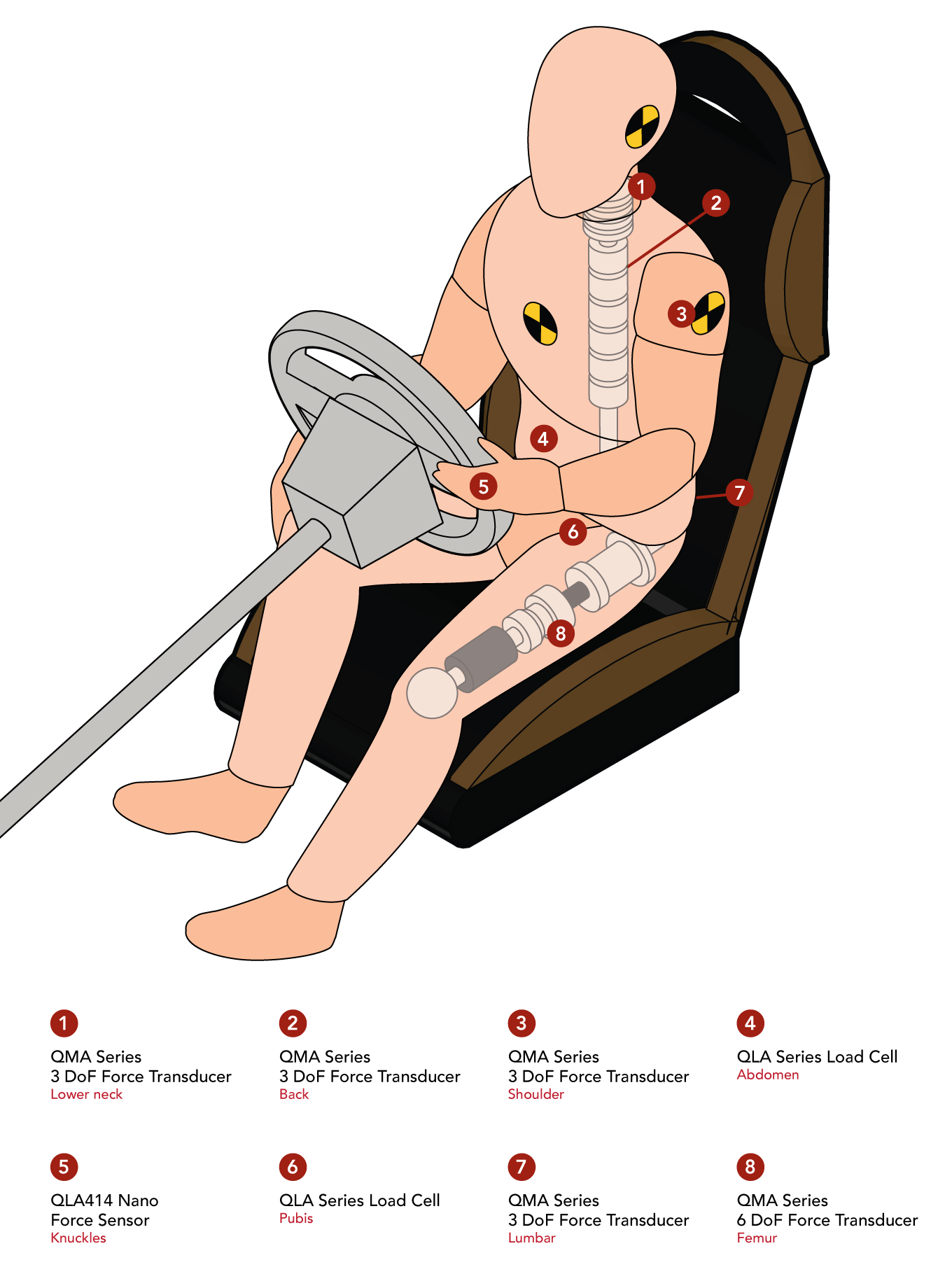How force and torque sensors are used in crash test dummies?
A crash test dummy - commonly known as Anthropomorphic Test Dummies (ATDs) – is a high-precision automotive test device used to measure human injury potential in simulated vehicle crashes. It simulates the dimensions, weight proportions, and joint and limb articulations of a human body during a traffic collision.
ATDs are instrumented with crash test dummy sensors mounted onto the main body joints and limbs. They are also equipped with data acquisition system capable of recording velocity of impact, chest displacement, deceleration rates and high-frequency forces exerted onto the test dummy at various instances. For example, the sensor in the torso of a crash-test dummy records the magnitude and direction of the net force acting on the dummy. The data collected is then used by researchers and test engineers to predict injuries in a crash and develop safer and more ergonomic vehicles.
Before the development of crash test dummies, dead bodies, animals and live humans were used to test safety features. As the engineers learned how to instrument dummies with transducers to measure force, acceleration, impact and displacement, they understood how they could predict injuries such as rib fractures, chest compressions, concussions, broken bones, muscle and soft tissue injuries.
A modern crash test dummy has over 200 force, torque and acceleration crash test sensors assembled all over the body.
What kind of sensors are used in crash test dummies?
Load cells and multi axis force torque sensors are employed throughout the crash test dummy body. They are located in the lower neck, back, shoulder, abdomen, hand knuckles, pubis, lumbar and femur.
Force-torque multi axis sensors simultaneously measure the magnitude and direction of forces and torques in up to 6 degrees of freedom (DoF): three perpendicular axial forces (Fx, Fy, Fz) and torque around these same axes (Mx, My, Mz). Multi-Axis sensors convert force and torque on different body parts during a crash into measurable electrical signals.
FUTEK offers a large selection of off-the-shelf force-torque sensors that are very well suitable for crash testing applications. FUTEK's in-house multidisciplinary engineering teams also develop cutting-edge custom sensors with unique geometries, performance capabilities and outputs to fit your application requirements. FUTEK force-torque crash test sensors are compliant with NHTSA FMVSS 208 Crash Test Procedures and Safety Requirements.
How it Works
Lower neck: QMA Series 3 DoF Force Transducer
Back: QMA Series 3 DoF Force Transducer
Shoulder: QMA Series 3 DoF Force Transducer
Abdomen: QLA Series Load Cell
Knuckles: QLA414 Nano Force Sensor
Pubis: QLA Series Load Cell
Lumbar: QMA Series 3 DoF Force Transducer
Femur: QMA Series 6 DoF Force Transducer
Products in Use
- QMA Series 3 DoF Force Transducer;
- QLA Series Load Cell;
- QLA414 Nano Force Sensor;
- QMA Series 6 DoF Force Transducer.
Contact Us
Please Contact Us with questions.
How force and torque sensors are used in crash test dummies?
A crash test dummy - commonly known as Anthropomorphic Test Dummies (ATDs) – is a high-precision automotive test device used to measure human injury potential in simulated vehicle crashes. It simulates the dimensions, weight proportions, and joint and limb articulations of a human body during a traffic collision.
ATDs are instrumented with crash test dummy sensors mounted onto the main body joints and limbs. They are also equipped with data acquisition system capable of recording velocity of impact, chest displacement, deceleration rates and high-frequency forces exerted onto the test dummy at various instances. For example, the sensor in the torso of a crash-test dummy records the magnitude and direction of the net force acting on the dummy. The data collected is then used by researchers and test engineers to predict injuries in a crash and develop safer and more ergonomic vehicles.
Before the development of crash test dummies, dead bodies, animals and live humans were used to test safety features. As the engineers learned how to instrument dummies with transducers to measure force, acceleration, impact and displacement, they understood how they could predict injuries such as rib fractures, chest compressions, concussions, broken bones, muscle and soft tissue injuries.
A modern crash test dummy has over 200 force, torque and acceleration crash test sensors assembled all over the body.
What kind of sensors are used in crash test dummies?
Load cells and multi axis force torque sensors are employed throughout the crash test dummy body. They are located in the lower neck, back, shoulder, abdomen, hand knuckles, pubis, lumbar and femur.
Force-torque multi axis sensors simultaneously measure the magnitude and direction of forces and torques in up to 6 degrees of freedom (DoF): three perpendicular axial forces (Fx, Fy, Fz) and torque around these same axes (Mx, My, Mz). Multi-Axis sensors convert force and torque on different body parts during a crash into measurable electrical signals.
FUTEK offers a large selection of off-the-shelf force-torque sensors that are very well suitable for crash testing applications. FUTEK's in-house multidisciplinary engineering teams also develop cutting-edge custom sensors with unique geometries, performance capabilities and outputs to fit your application requirements. FUTEK force-torque crash test sensors are compliant with NHTSA FMVSS 208 Crash Test Procedures and Safety Requirements.

